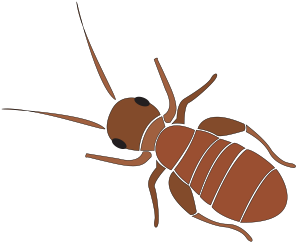Katie Risseeuw pulls out an ancient German book from its specially made protective sheath. It’s a sad little book, the sort of thing you find in a dead relative’s basement.

“You can see it here,” she says, pointing to a series of ant farm-like tunnels running through the binding. “They ate through the hide cover and kept boring through.” A preservation librarian, Risseeuw is in charge of the University Library’s Integrated Pest Management (IPM) system. It’s a fancy way to refer to one of the library’s most basic purposes: keeping the books safe from destructive forces.
The North Shore doesn’t offer much in the way of wild animals other than the occasional skunk. It’s a safe place, where tiny animals can’t rot your body from the inside out.
Unless, of course, you’re a book.
Here’s the problem libraries face: The older the book, the more likely the binding is made of natural substances, like hide, animal glue or starch. Certain insects like silverfish, psocids (known as booklice) and dermestids (you know their relatives as flesh-eating beetles) find these materials delicious. Left to their own devices, they’ll devour old book bindings and pages. For Northwestern, which maintains important collections of books, this is an unwelcome option.
Maintaining and preserving book collections has only recently gotten easier. Until the 20th century, doing so meant keeping books in a cool, dry place and hoping for the best. Now, the library brings an arsenal of modern tools to fight pests.
The primary tool of IPM is a small white triangle of paper called a bumble trap. It’s non-lethal, so as not to harm students or books. It lets preservation librarians figure out what animals are eating. These traps are left at strategic locations throughout the library, where most will hopefully trap nothing. If insects have managed to scuttle their way into the library, then they’ll go under a microscope and be identified—“the fun part,” Risseeuw says. Preservation makes recommendations to Facilities Management about how to adjust the temperature or humidity, and the library hums along.
Of course, not everything is quite so simple. Though most pests can be repelled by keeping the area cool and dry, some are harder to repel. Students are a grubby lot who tend to eat where they aren’t allowed (“I’ll look in the trash and see edamame and think, you know, that’s not an appropriate library food,” Risseeuw says).
Once, a piece of Ghanaian art intended for the Africana collection was found to have wood-boring beetles inside that were eating away at the innards of the painting. A painting, of course, can’t be rebound the way a book can, so librarians were forced to take the more drastic measure of freezing the painting.
Not all pests can be dealt with as swiftly. When psocids have eaten through the binding or flesh-eating beetles have wrecked a cover, a book worth preserving must be whisked away to the preservation lab. Tucked away in the Main Library basement, the lab contains the sort of tools necessary to make old books new again.
A corner of shelves in the Preservation Department is devoted to books that have gotten too worn down to circulate. Most of them have indentations on their spines, where the binding has worn away to reveal string and paste, caused by students pulling books off the shelves by their tops.
When asked if students are the library’s biggest threat, Risseeuw is quick to rebut.
“It’s good. They’re using books. That’s why we’re here.” She pauses.
“But also, yes.”